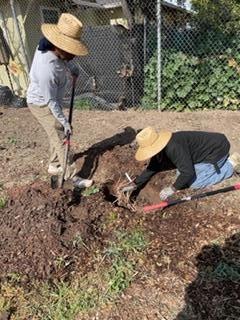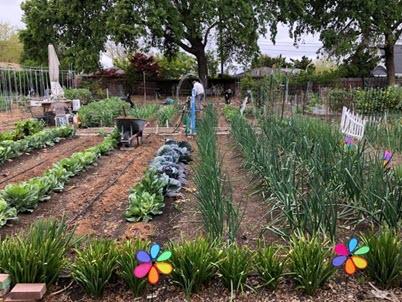The Latest Dirt - July 2022
Understanding Community
By Karen Maggio
Currently, the Contra Costa Community Garden team serves 14 very different community gardens and urban farms throughout the county. On any given day, UC Master Gardener volunteers can be found in small private residential or treatment program gardens, larger public facing community gardens, or out in east county urban farms.

Community is defined by the Oxford dictionary as “a group of people living in the same place with shared interests” also “working together to bring about change.” All of these community gardens and urban farms are about building community and a desire to make a positive impact in people’s lives. Bringing about change to a financially challenged neighborhood or to a group of high- risk young people is part of that community building. No matter what one’s circumstance, it is surely made better by a relationship with nature and being with others.
At Family Harvest Farm, aged-out foster kids, in paid apprenticeships, share life experiences and a desire to build a future working on the land. They are mentored by a paid garden manager who was once a foster kiddo herself. Three miles down the road, a very low-income housing project on El Pueblo Avenue has inspired a former resident to lift this neighborhood up. He is now providing farm apprenticeships, healthy fresh food and education on a once hot, dry and weedy ball field next door, known as Healthy Hearts Institute.
Sure, the big ideas and good intentions are admirable, even award-winning, but the work is not easy. Mother Nature, partnering with climate change, has added to their burden with increased drought, summer fires, and poor air quality. The physical labor required to keep up a two- to five-acre farm is unrelenting and not yet financially self-sustaining. It is still “early days” and the potential for funding shortfalls is a daily concern.
In addition to the physical and financial challenges on these mission-driven farms, there exists a distrust of new faces, self-esteem issues, and ever-churning crises at home that cause some apprentices to quit the program early on.

As UC Master Gardeners, we come into these communities and gardens armed with basic tools and UC-based horticultural knowledge only to discover that one size does not fit all. Who among us has not walked into a meeting or class, sometime in our life, ill-prepared? Uncomfortable, yes, but usually a learning experience that gives us encouragement to do better next time around. The mantra for any good public speaker or teacher is to “know your audience” and our work in the community is no exception. What may work for one group is sometimes completely wrong for another. Language barriers, varying levels of availability, ability and learning skills, and different locations make each community garden program and its participants unique. Sure, we do a better job at some of our locations than others, judging from interest levels and numbers served, but our biggest challenges are generally where we have less experience or are presented with brand new settings.
Although we have a lot of learning and work ahead, this community garden team is working together to implement new and innovative approaches to better serve all of these communities.
- Coordinating events with Spanish-speaking CoCoMGs in community gardens, located in Spanish speaking communities, is what Jardineros team members Anne Sutherland and Neal Hoellwarth are doing at Ambrose Community Garden in Bay Point. By providing the right support to address this community’s need, we hope to see an increase in programs and participation.
- Designing a new pocket demonstration garden within the large Concord- based Gehringer community garden farther away from a UC demonstration garden is what Phil Quinlan and Karen Goodman are creating as a teaching and demonstration tool for the over 100 gardeners with plots at this location. It not only provides a visual example of best practices, but also provides UC Master Gardener volunteers with a place to show off their knowledge and have fun too.
- Creating shorter classes with a visual learning approach tailored to urban farm apprentices is something that our teachers are exploring at Family Harvest Farm. Many of these garden and farm locations do not have indoor classrooms, so visual aids (sometimes edible) are essential to the learning process.
- Organizing work parties that bring out UC Master Gardener volunteers to guide and train first time community volunteers with limited knowledge is helping to put more shovels in the ground. This allows these gardens to support a larger number of volunteers than would be manageable for the small on-site staff alone. Kim Overaa, Bob Archer, Jan Manns, Allison Thomas, Suzanne Miller and others have recently been out guiding volunteers in the field. The results … positive team and community building. Oh, and a lot of work gets done, too!
How much progress we make depends on how well we adapt to ever changing circumstances and our ability to understand what success looks like. For now, it’s learning by doing. We will report back with the feedback that we gather.
